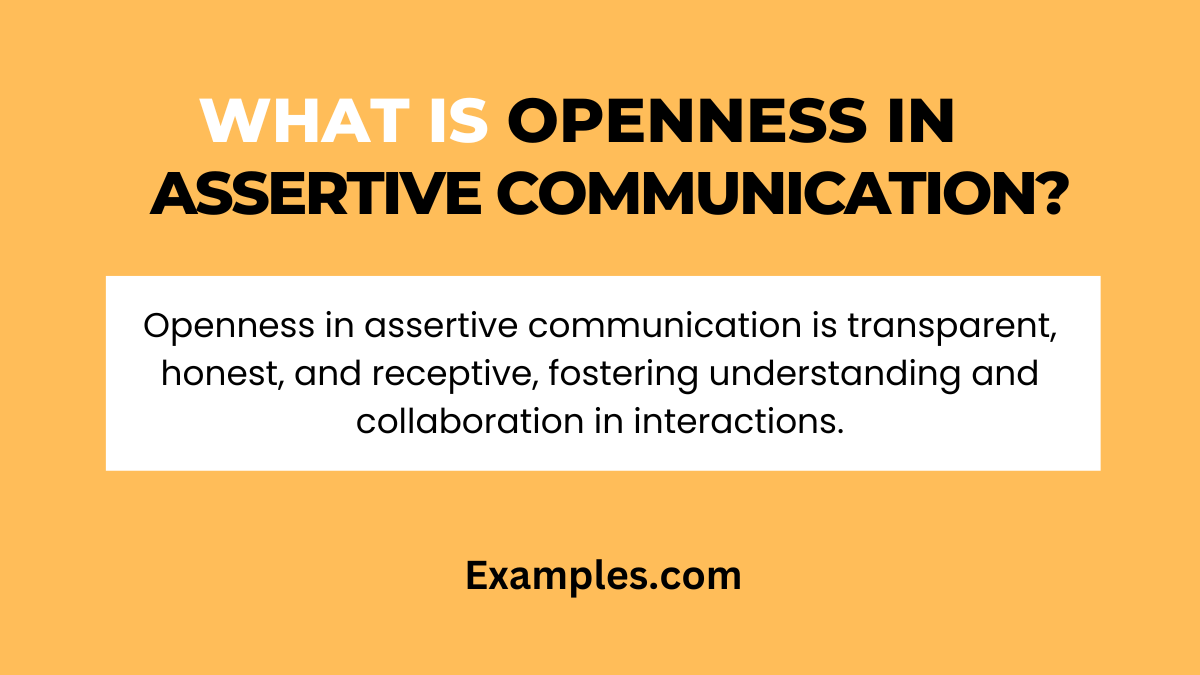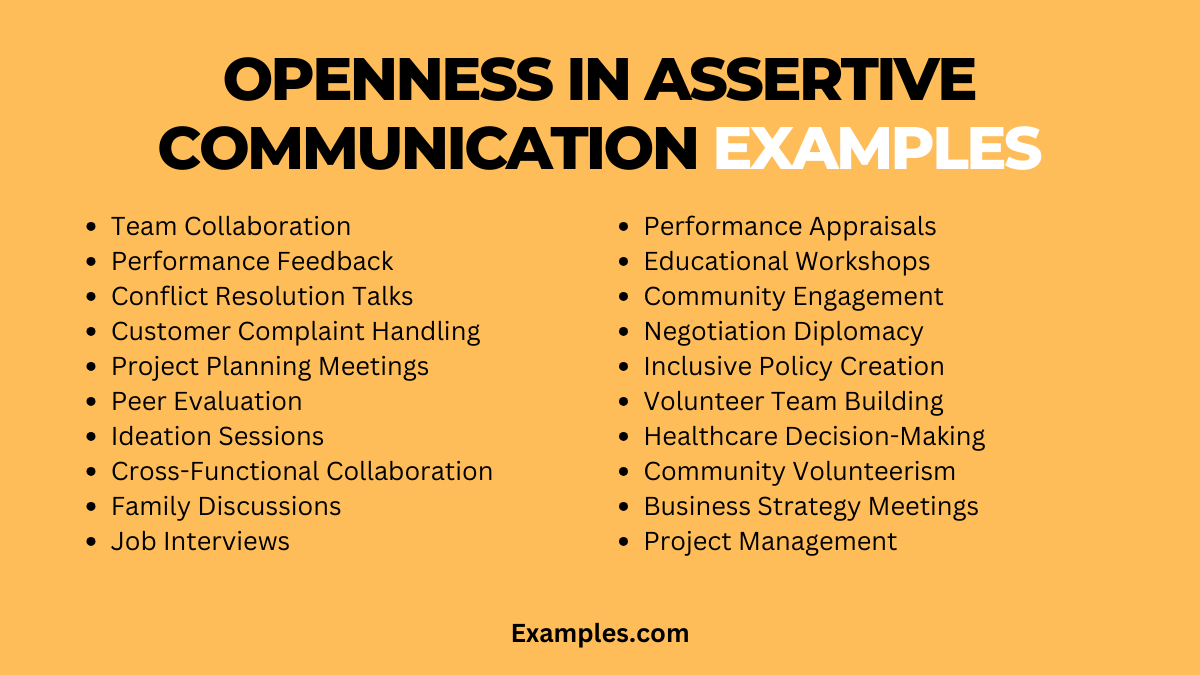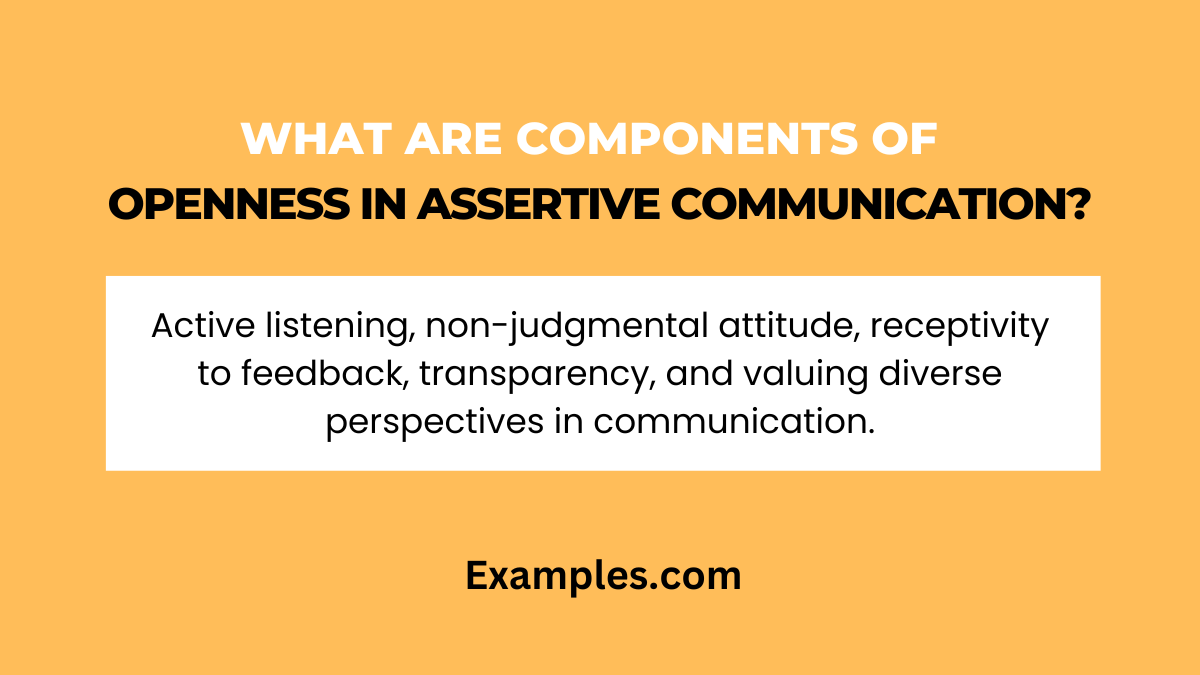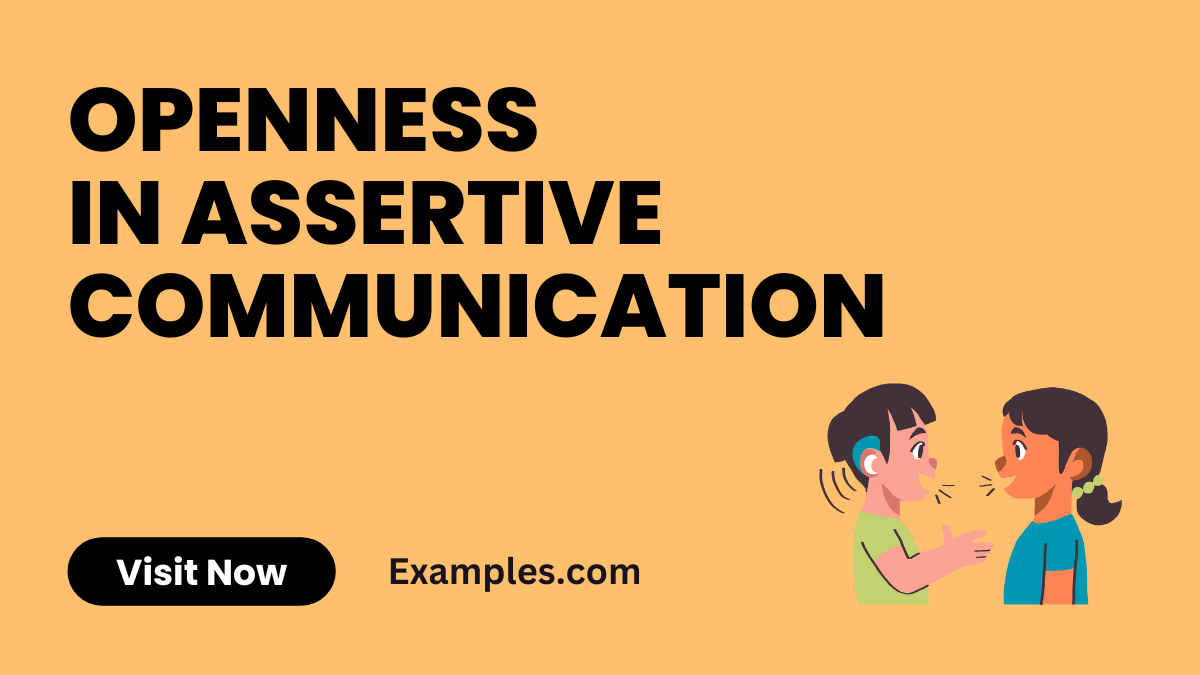19+ Openness in Assertive Communication Examples
Unlock the power of Openness in Assertive Communication to enhance interpersonal connections. Communication Examples play a pivotal role in illustrating the impact of an open approach. Understanding the essence of openness is key to mastering assertiveness, creating a positive and impactful communication style.
What is Openness in Assertive Communication?

Openness in Assertive Communication involves expressing thoughts honestly, embracing transparency, and welcoming diverse perspectives. This approach fosters healthy dialogue, contributing to effective and respectful interactions. In essence, openness signifies receptiveness and authenticity in assertive communication.
20 Openness in Assertive Communication Examples

In various contexts, openness in assertive communication fosters positive interactions. Embracing diverse viewpoints in team collaboration enhances creativity and innovation. Performance feedback handled openly encourages growth in professional settings. Openness in conflict resolution ensures respectful resolutions, while customer complaint handling with empathy strengthens satisfaction. From job interviews to family discussions, an open-minded approach builds harmonious relationships. Whether in educational workshops or community engagement, openness cultivates understanding and inclusivity. Across diverse scenarios, practicing openness in assertive communication leads to more collaborative, empathetic, and effective interactions.
- Team Collaboration: Embrace openness in group discussions, valuing every team member’s input for innovative solutions.
- Performance Feedback: Provide constructive criticism openly, fostering growth and improvement in professional settings.
- Conflict Resolution Talks: Approach conflicts with openness, understanding opposing viewpoints for amicable resolutions.
- Customer Complaint Handling: Respond to complaints with an open mind, offering empathetic solutions for customer satisfaction.
- Project Planning Meetings: Encourage open dialogue during project planning, ensuring collective insights shape effective strategies.
- Peer Evaluation: Evaluate peers’ work openly, recognizing strengths and offering constructive feedback for improvement.
- Ideation Sessions: Cultivate an open-minded atmosphere in brainstorming sessions, allowing creativity to flourish.
- Cross-Functional Collaboration: Promote openness in cross-functional collaborations, integrating diverse perspectives for success.
- Job Interviews: Showcase openness by considering diverse skills and experiences when interviewing candidates.
- Family Discussions: Navigate family discussions with openness, valuing each member’s perspective for harmonious relationships.
- Performance Appraisals: Conduct open discussions during appraisals, recognizing achievements and discussing areas for growth.
- Educational Workshops: Encourage open communication in educational workshops, creating an environment for active participation.
- Community Engagement: Engage with the community openly, valuing diverse opinions for impactful initiatives.
- Negotiation Diplomacy: Exhibit openness during negotiations, seeking compromise for mutual benefit.
- Inclusive Policy Creation: Formulate inclusive policies, considering diverse needs and viewpoints for effective governance.
- Volunteer Team Building: Promote open-mindedness in volunteer teams, enhancing collaboration and camaraderie.
- Healthcare Decision-Making: Consider varied medical opinions for holistic healthcare decisions, reflecting an open-minded approach.
- Community Volunteerism: Contribute to community projects with an open mind, respecting diverse backgrounds and needs.
- Business Strategy Meetings: Encourage openness in strategy discussions, ensuring collective insights shape business decisions.
- Project Management: Approach project management with an open mind, adapting strategies based on team input and insights.
Openness in Assertive Communication Examples for Students
In group projects, encourage classmates to share diverse ideas openly, fostering collaborative learning. Facilitate open discussions during seminars, promoting active student participation and varied perspectives. Embrace feedback with openness, promoting a culture of continuous improvement. During debates, listen receptively to opposing viewpoints, contributing to a well-rounded discussion.
- Classroom Discussions: Students share diverse perspectives, fostering a rich learning environment.
- Group Projects: Communicating ideas ensures collaboration for successful project outcomes.
- Peer Feedback: Providing/receiving feedback enhances academic growth and mutual understanding.
- Debates: Engaging in assertive debates hones critical thinking skills and encourages dialogue.
- Student Meetings: Expressing concerns in meetings promotes an inclusive campus culture.
- Social Events: Open communication strengthens student connections and community bonds.
- Study Groups: Sharing thoughts in study groups enhances academic success.
- Presentations: Articulating ideas in presentations contributes to effective knowledge sharing.
- Conflict Resolution: Resolving conflicts through open dialogue fosters a positive campus environment.
- Leadership Discussions: Open communication in leadership discussions promotes transparent decision-making.
Openness in Assertive Communication Examples for Patients
In healthcare consultations, encourage patients to openly express their symptoms and concerns. Foster an environment where patients feel comfortable sharing their medical history openly for accurate diagnosis.
- Medical History Disclosure: Patients sharing history aids accurate diagnosis and treatment.
- Symptom Descriptions: Communicating symptoms ensures effective medical evaluation and care.
- Treatment Preferences: Discussing preferences allows for personalized healthcare decisions.
- Concern Expression: Expressing concerns ensures thorough and compassionate medical attention.
- End-of-life Discussions: Communicating preferences facilitates patient-centered care.
- Follow-up Questions: Asking questions fosters understanding and collaboration in healthcare.
- Pain Management: Discussing pain levels ensures tailored management strategies.
- Medication Adherence: Discussing concerns supports adherence and treatment effectiveness.
- Mental Health Discussions: Addressing mental health fosters understanding and appropriate interventions.
- Rehabilitation Plans: Expressing preferences enables personalized recovery strategies.
Openness in Assertive Communication Examples in Business
Promote an open-door policy, inviting employees to share ideas and concerns openly. In team meetings, encourage members to express diverse opinions openly, fostering innovation. Discuss performance feedback openly, focusing on growth and development.
- Team Meetings: Open communication encourages idea exchange and problem-solving.
- Performance Reviews: Providing feedback promotes professional growth.
- Client Presentations: Presenting ideas ensures transparent communication.
- Conflict Resolution: Addressing conflicts leads to timely resolutions.
- Innovation Workshops: Encouraging communication fosters creative solutions.
- Project Updates: Sharing updates ensures all team members are informed.
- Employee Surveys: Seeking feedback promotes a positive work culture.
- Leadership Discussions: Communicating vision fosters trust and team alignment.
- Customer Feedback: Addressing feedback strengthens client relationships.
- Diversity Initiatives: Discussing initiatives promotes an inclusive work environment.
What are Components of Openness in Assertive Communication?

- Transparency: Share thoughts and information openly.
- Receptivity: Listen actively and non-judgmentally.
- Honesty: Communicate with sincerity and integrity.
- Flexibility: Adapt to others’ perspectives willingly.
- Vulnerability: Express emotions and needs openly.
What is Openness in Assertive Communication Style?
Openness involves transparent, honest, and receptive communication, fostering understanding and collaboration. It emphasizes embracing diverse perspectives with adaptability and vulnerability.
Tips for Effective Openness in Assertive Communications:
- Transparent Expression: Communicate thoughts openly.
- Active Listening: Listen receptively without judgment.
- Honest Feedback: Provide sincere and constructive feedback.
- Adaptability: Embrace diverse viewpoints willingly.
- Emotional Expression: Share feelings and needs openly.
Openness in assertive communication is a pivotal element that fosters a positive and constructive dialogue in various spheres of life. By embracing transparency and honesty while respecting others’ viewpoints, individuals can create an environment conducive to mutual understanding and growth. This approach is particularly beneficial in conflict resolution, team collaboration, and leadership, where open communication can lead to innovative solutions and stronger relationships. Moreover, openness in communication is not just about speaking your mind; it’s also about being receptive to feedback and other perspectives, which is essential for personal development and effective interpersonal relationships.
To gain further insights into the benefits of open communication in professional environments, the Harvard Business Review is a valuable resource. Their articles provide in-depth analysis and practical advice on various aspects of workplace communication, including assertiveness and openness. Additionally, the American Psychological Association offers comprehensive resources on the psychological aspects of communication. Their research and publications delve into how openness impacts interpersonal dynamics and can be effectively incorporated into assertive communication strategies. These resources can greatly enhance one’s understanding and application of open assertive communication in both personal and professional contexts.



